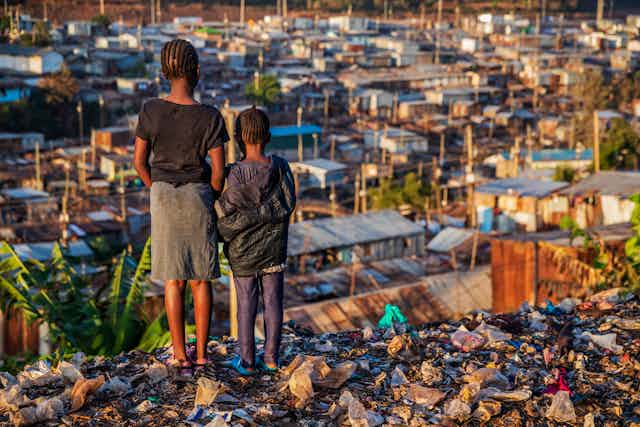Housing is a critical social determinant of health. The World Health Organization (WHO) defines healthy housing as a shelter that supports physical, mental and social wellbeing.
The WHO has developed guidelines outlining the attributes of healthy housing. These include structural soundness, as well as access to a local community that enables social interactions. Healthy housing protects inhabitants from the effects of disasters, pollution, waste and extreme heat or cold. It provides a feeling of home, including a sense of belonging, security and privacy.
Health risks in the home environment are important to think about because of the amount of time people spend there. In countries where unemployment levels are high or where most work is home based, people spend more than 70% of their time indoors. Children especially spend a large amount of time at home, which exposes them to any health risks in the home environment.
We are researchers from the African Population and Health Research Center with an interest in urbanisation and population dynamics. We recently set out to study the link between housing and children’s health. We found that healthy housing generally lowered the chances of children falling ill with three diseases that we tracked: diarrhoea, acute respiratory illnesses and fever.
The impacts of housing quality extend beyond health and can have significant implications for education and subsequent economic outcomes, particularly for children.
The research
Rapid urbanisation and population growth in Africa have pushed many people into informal settlements. Sub-Saharan Africa has 65% of the world’s slum dwellers. This population generally lives in poor housing that lacks access to clean water, sanitation and hygiene services. The structures are overcrowded. They tend to have leaking roofs and damp walls, floors and foundations. They may also have indoor pollution, compromising the health of millions of people.
We set out to evaluate the relationship between healthy housing and the likelihood of children falling sick across six African countries: Burkina Faso, Cameroon, Ghana, Kenya, Nigeria and South Africa.
We studied the incidence of diarrhoea, acute respiratory illness and fever among children under the age of five. These three conditions can have severe consequences for child health and wellbeing.
Diarrhoea and acute respiratory infections are leading causes of disease and deaths in children aged below five worldwide. Diarrhoea accounted for 9% of all deaths among children under five in 2019. Acute respiratory illnesses caused about 20% of deaths among children in this age group. The burden of under-five deaths linked to diarrhoea and respiratory illnesses like pneumonia is higher for children in developing countries than those in developed regions.
We selected the six countries in our study because they provided data on the three diseases we tracked. They also allow for a comparative analysis across African countries. Our study used the latest available demographic and health survey data at the time of our research: Burkina Faso (2010), Cameroon (2011), Ghana (2014), Kenya (2014), Nigeria (2018) and South Africa (2016). We sampled data on 91,096 children aged under five.
The findings
Our study found that healthy housing was generally associated with reduced odds of contracting the three illnesses we considered: diarrhoea, acute respiratory illness and fever. Our definition of healthy housing considered several attributes, including sanitation, drinking water sources and housing characteristics.
Homes that protect occupants from the elements, ensure access to adequate space and reduce overcrowding help keep children healthy. Homes that use cleaner cooking and lighting fuels reduce household air pollution, which leads to lower chances of respiratory infections.
Children living in healthy housing had fewer incidences of fever in all countries apart from South Africa. Here, children living in the healthiest homes are twice as likely to have fever than those living in unhealthy homes.
Fever is an indication of an underlying infection that could be viral or bacterial. Such infections are common in South Africa. In addition, the main causes of fevers among children under five are diarrhoea and acute respiratory illnesses. Among the countries included in the analysis, South Africa had the highest proportion of young mothers (aged below 25) and never-married mothers. This increases the chances that these mothers are engaged in work outside the home, leading to the early introduction of complementary feeding. This has been shown to increase the incidence of diarrhoea. These results call for addressing the causes of diarrhoea and respiratory illnesses by, for instance, ensuring South African homes have access to clean drinking water, adequate sanitation and clean energy for cooking.
While healthy housing is crucial, it’s not the sole determinant of a child’s health. Other factors, such as a sense of community, environmental exposure, parental education, income levels, healthcare access, and maternal and child-level factors also contribute to the overall health status of children. For instance, we found that children in Burkina Faso who were not breastfed had higher chances of getting diarrhoea than those who were breastfed despite the condition of their housing. This tracks with studies that have documented that breastfeeding has a protective role over gastrointestinal and respiratory tract infections among children.
What next
From our findings, parents can improve the wellbeing of their children by implementing simple strategies. This includes ensuring they use clean energy for cooking to reduce indoor air pollution and consequently reduce the incidence of acute respiratory illnesses. Similarly, using clean drinking water, hand washing and improving sanitation can help reduce cases of diarrhoea.
Bold but nuanced policy and programme government-level interventions can also help address the incidence of diseases affecting children under five in Africa. This requires efforts that go beyond just addressing the issue of housing to working with complementary sectors, like health, urban planning, environment and education.

